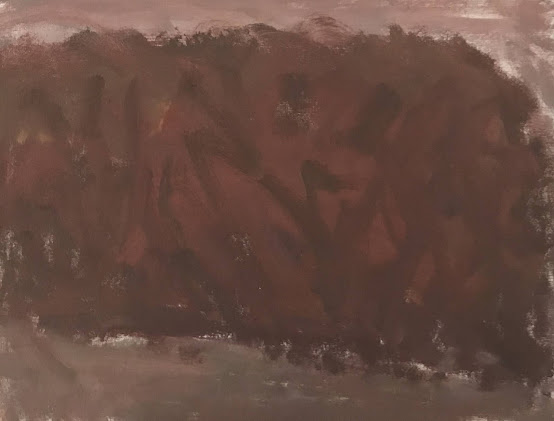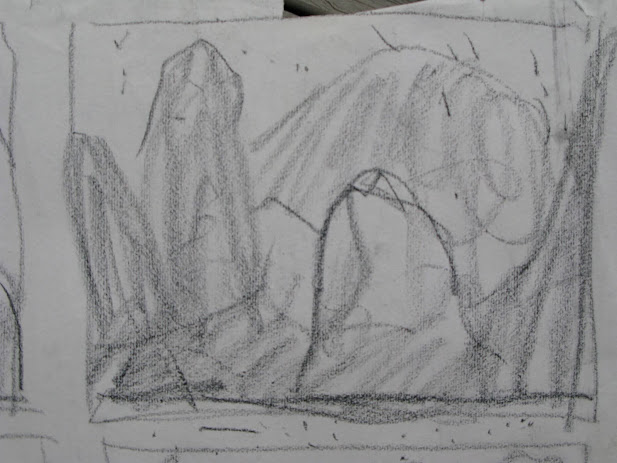SLA
31 December 2021
the past and present, the known and unknown
23 December 2021
Vincent Van gogh meets an unknown British painter (?)
20 December 2021
REDinc! and the wonders of expression
18 December 2021
Letting the batter walk
LCM
This feeling comes over me that sometimes these paintings are almost pulled out of me, yanked from my will power, from my hands like some force out in the wild landscape resisting my hold over the picture. It is if while driving a car, a ghost suddenly grabs the steering wheel out of my hands.
As writers will often lament when their own characters go AWOL or off-script, so too, do painters when their pictures go out of control.
LJA
10 December 2021
Sidney Nolan at Heidi, Vanessa Bell at Charleston
07 December 2021
recent studies under the watchful eyes of la Nina
04 December 2021
Henry Moore the Masseur, facts and feelings
So in a sense, I wonder if one needs to fall in love with the work in order to fall in love with the artist? Or, like in so many novels, fall in love with the artist to see their work?
Just looking at the head alone (far below) one thinks of Picasso, then of course the body reenforces this idea. Picasso was making things like this one done in 1929 long before Moore made Reclining Figure. This was an age when reality was being questioned in every corner of the industrialised world, from science and medicine, to physics and philosophy, to music and architecture. The visual world of art was also on the front line in these 20th century adventures of human thought.
Henry drew everyday in later life when he was housebound and going blind according to his daughter, Mary Moore. She described the drawings as "somewhat fantasy, internalised drawings, and things from memory".
My very favourite anecdote about Henry Moore was that when he was a small child he often gave back massages to his mother. So, it makes perfect sense he would become either a sculptor or chiropractor.
01 December 2021
Narcissus
29 November 2021
Cambodia genocide
I think I tried to post this a million years ago in this Blog space but it never worked due to technical problems. I made it nine years ago (so Vimeo reminds me). I went to Cambodia around 2005 on one of my drawing trips to Vietnam and I loved it. But it seems sad to me for a few reasons. The main one was that Pol Pot had killed off so much of the male population as well as most of the University trained citizens, both women and men. But then the children were not spared either. Phenom Penh was a poor city and people despaired even after so many years after the fall of the Khmer Rouge. At the museum I made these photos and found myself wanting to make a slide show of it but it took me several years to face it. The beautiful music of Arvo Part accompanies these pictures. I regret a little that his music has since become so popular, so ubiquitous everywhere, but then, he deserves success.
I re-watched this recently, as I have a number of times over the years. It always hits me hard. And it's always in the most fragile place where I cannot protect myself from that terrible pain in front of such cruelty that one sees in the dark corners of humanity. When seeing this I always need a box of tissues nearby.
26 November 2021
the bumbling tourist discovers Basho the invisible
25 November 2021
A faked painting! Alas!
Châteaunoir, Octobre 2018
There is something wrong with this small study. It was done in the forest of the Chateaunoir during my last trip there in the October month of 2018 which I wrote about the other day.
But I do find it intriguing, just deficient in a most essential way. It has a kind of flash that advertises a certain skill, as if it might be a good painting, but honestly, it really doesn't come together as a whole and it lacks integrity because of this. It is a faked painting! It appears to be more than it poses to be, and like the British say:
"It's mutton all dressed up as Lamb!"
But curiously, most people might be more seduced by it than the one below which is far more unified yet it would not draw the same interest from the public. It's a painter's painting.
It is unified but probably too 'painterly' for the public to accept as a landscape which it is, for it was done at the end of the day below Poet Laval. I went several late afternoons to paint in a field and I loved painting there. Incredibly, I wasn't painting landscapes around Dieulefit when I lived there, this kills me to think of it.
The Autumn and Winter months are divine in terms of colour. None of those distracting greens everywhere, just mysterious violets.
I had not seen the painting below since I made it three years ago, I had liked it then but I really like it now. It is so 'Expressionist' in feeling it confirms my thinking that I secretly wish to re-moor the entire school of 'American Expressionism' back to Nature, back to the laws of Nature more specifically (even though the American Expressionist School was not derived from Nature, as we know it). This would be a Herculean task by any means, so it is just on my wish-list, my to-do list for someday, a bucket-list of sorts.
The person who might like this picture would be someone who loves the expressive nature of paint and painting. This would most likely exclude a vast majority of the public who expect a more sentimental verisimilitude in a 'Landscape' painting. Alas!
Poët Laval November 2018 35 X 27 cm
22 November 2021
Châteaunoir, still a souvenir in painting
When I was back in France three years ago I put together the very minimal things I would need to step out and work in Nature, a palette, easel, and bought some colours and brushes. I had not anticipated to paint at all. I was going over to 'write' and 'think' (ha ha). For some reason I couldn't foresee making an ambulant studio in the boot of the small Citroen C3 I had rented. Though I did write I mostly spent a great deal of time driving around France, all the time in fact. And naturally I watched the foliage cycle through the colour wheel into early winter. In Grignan where I was based I gratefully watched snow accumulate on the roads one night before heading back to London at the end of November.
But late October I stayed at the Châteaunoir where Charlotte Tessier kindly lent me her apartment off the courtyard. It was so familiar, all of it; the smell of all those pine and oak trees especially after a rain, St. Victoire looming like a grandfather in the East, lots of cats though not as many, nor as friendly in my day. Even Mazout (heating oil) not used in decades had somehow lodged its unique scent into the kitchen walls and tiles permeating one's sleep. Through my all senses I had returned back to Aix and my youth. All of it brought on so many memories, nostalgic yes, but not at all cloying or sad as I had moved on. All these memories though are like finding old photos in a desk drawer. That was then, this is now. I was left feeling like I wanted to keep moving, and this was good because it means I had changed. Unlike so many people, I had always seemed to be someone with a club foot still dragging the past with me in discomfort.
On the upside, I was connecting with so many old and dear friends, especially being so close to Poussey (the owner), with whom I had coffee every day just like in the old days. And yet, as much as I loved being there I was also happy to leave, to keep moving forward.
During those 10 days or so I walked a lot on those familiar paths which all seem to end up at the top of the plateau. And I set up to paint just for fun. I was curious to see how I might conceive a small picture in the riot of colour around the infamous and much celebrated Châteaunoir. I found it difficult, but not without great pleasure. And as I regularly exclaimed so many years ago whilst painting in that forest: "What am I doing?? This is way too complicated!!"
Mixing this palette of these forest colours was fun too, so different than the one I prepare in here Australia.
The top painting, (above) is made up of splotches of colour without too much concern for the drawing (though the drawing is in the splotches) whereas the one below is conceived equally by the colours and drawing. They are different but both seem to me, as they did at the time, not quite paintings but more souvenirs. There is nothing wrong with that. More than ever, I am after the conveyance of feeling, technique be damned. And souvenirs are keepsakes.
19 November 2021
Pipe-bomb dreams; Bush's criminal war on Iraq, trauma twenty years on
These photos by James Hill are from an article in the New York Times that appeared today, 19 November 2021.
It is hard to fathom a fraction of the suffering caused by, not only the Right Wing of the Republican Party, but the cowardly or ignorant Democrats, and the large population of under-educated Americans who all united to back the destruction of Iraq back in 2003. (even against Trump, I refused to vote for Hilary Clinton because of her support for this war)
All for nothing, except to make money for the American arms industries which created endless profit and conflict in the Middle East. All that killing and maiming for what end?
American soldiers and Iraqis citizens all suffered the same fate, the same shallow grave. But unlike the Iraqi people, the American soldiers at least for the most part, were shuffled through various hospitals with basic medical care.
Amazingly, not one of these politicians or policy advisors ever faced any consequences for this war crime. Indeed, America today is now the land of the free (of consequences) if one is powerful and white.
And so, almost twenty years on, refugees are still on the move to flee a once prosperous region. And yes, Iraq was run by a dictator, but its citizens lived in a relatively safe country, a society with universities and hospitals and a robust economy. What did America offer the people of Iraq? Pipe-bomb dreams?
These refugees from the Middle East will join the millions more already on the move from climate change. It has proved to become a prolonged version of World War II.
Will we ever have get decent, intelligent and wise leaders?
18 November 2021
a painter gets it right or dies
MBG
15 November 2021
Halong Bay Vietnam, a few drawings from 2004


















































